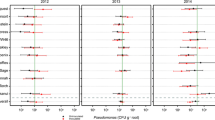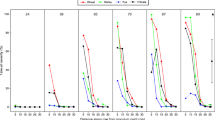Abstract
The rate of inoculum decline was determined for Gaeumannomyces graminis var. tritici (Ggt), a fungus causing take-all in cereals which survives saprophytically on crop debris during the intercrop period. Crop residues and Ggt inoculum in soil cores containing residues of six wheat cultivars from two fields were assessed in three experiments at intervals up to 7 months after harvest. At that time, for all cultivars, approximately three quarters of the original residue plant mass remained from crop residues where the stems were on the soil surface. The quantity of Ggt DNA per plant declined on average by 95% after 7 months, with most of the remaining inoculum residing in the stems and crown. Viable inoculum remaining in the plant residues was sufficient to infect newly planted wheat seedlings. It appears that after harvesting wheat exhibiting take-all, a period of more than 7 months is required to ensure inoculum in residues has declined sufficiently in soil to prevent reinfection of Ggt-susceptible cereal crops.






Similar content being viewed by others
References
Bailey DJ, Gilligan CA (1999) Dynamics of primary and secondary infection in take-all epidemics. Phytopathology 89:84–91
Bauer J, Kirschbaum MUF, Weihermueller L, Huisman JA, Herbst M, Vereecken H (2008) Temperature response of wheat decomposition is more complex than the common approaches of most multi-pool models. Soil Biol Biochem 40:2780–2786
Bithell SL, McLachlan ARG, Hide CCL, McKay A, Cromey MG (2009) Changes in post-harvest levels of Gaeumannomyces graminis var. tritici inoculum in wheat fields. Australas Plant Pathol 38:277–283
Bithell SL, McKay A, Butler RC, Herdina O-KK, Hartley D, Cromey MG (2012) Predicting take-all severity in second-year wheat using soil DNA concentrations of Gaeumannomyces graminis var. tritici determined with qPCR. Plant Dis 96:443–451
Chng SF, Cromey MG, Butler RC (2004) Mycoflora of rhizomes and roots of Elytrigia repens, a potential inoculum source for take-all in wheat. New Zealand. Plant Prot 57:59–66
Chng SF, Cromey MG, Butler RC (2005) Evaluation of the susceptibility of various grass species to Gaeumannomyces graminis var. tritici. New Zealand. Plant Prot 58:261–267
Committee GS (2014) The guide to the GenStat® command language (release 17). VSN International, Hemel Hempsted
Cook RJ (2003) Take-all of wheat. Physiol Mol Plant Pathol 62:73–86
Cookson WR, Beare MH, Wilson PE (1998) Effects of prior crop residue management on microbial properties and crop residue decomposition. Appl Soil Ecol 7:179–188
Curtin D, Francis GS, McCallum FM (2008) Decomposition rate of cereal straw as affected by soil placement. Aust J Soil Res 46:152–160
CycSoftware (2009) CycDesigN 4.0 a package for the computer generation of experimental designs. Version 4.0, CycSoftware Ltd, Hamilton
Douglas CL Jr, Richman RW (1992) Estimating crop residue decomposition from air temperature, initial nitrogen content, and residue placement. Soil Sci Soc Am J 56:272–278
Fraser PM, Williams PH, Haynes RJ (1996) Earthworm species, population size and biomass under different cropping systems across the Canterbury Plains, New Zealand. Appl Soil Ecol 3:49–57
Fraser PM, Curtin D, Harrison-Kirk T, Meenken ED, Beare MH, Tabley F, Gillespie RN, Francis GS (2013) Winter nitrate leaching under different tillage and winter cover crop management practices. Soil Sci Soc Am J 77:1391–1401
Harbridge J (2007a) Determination of ammonia (Salicylcate) in 2M KCl soil extracts by flow injection analysis (high throughput), Lachat QuikChem method 12–107–06-2-F. Lachat Instruments, Loveland
Harbridge J (2007b) Determination of nitrate in 2M KCl soil extracts by flow injection analysis, Lachat QuikChem method 12–107–04-1-J. Lachat Instruments, Loveland
Herdina NS, Jabaji-Hare S, Ophel-Keller K (2004) Persistence of DNA of Gaeumannomyces graminis var. tritici in soil as measured by a DNA-based assay. FEMS Microbiol Ecol 47:143–152
Hornby D (1981) Inoculum. In: Asher MJC, Shipton PJ (eds) Biology and control of take-all. Academic Press, London, pp 271–293
Hornby D, Bateman GL, Gutteridge RJ, Ward E, Yarham D (1998) Take-all disease of cereals: a regional perspective. CAB International, Wallingford, p 384
Hume EA, Horrocks AJ, Fraser PM, Curtin D, Meenken ED, Chng S, Beare MH (2015) Alleviation of take-all in wheat by the earthworm Aporrectodea caliginosa (Savigny). Appl Soil Ecol 90:18–25
Kain WM, Young J (1975) I. A soil sampler suitable for sampling pastureland. N Z J Exp Agric 3:177–180
Keenan S, Cromey MG, Harrow SA, Bithell SL, Butler RC, Beard SS, Pitman AR (2015) Quantitative PCR to detect Gaeumannomyces graminis var. tritici in symptomatic and non-symptomatic wheat roots. Australas Plant Pathol 44:591–597
Keeney DR, Nelson DW (1982) Nitrogen - inorganic forms. In: Page AL, Miller RH, Keeney DR (eds) Methods of soil analysis, part 2. Chemical and microbiological properties. American Society of Agronomy and Soil Science Society of America, Madison, pp 643–709
Lee Y, Nelder JA, Pawitan Y. 2006. Generalized Linear Models with Random Effects: Unified Analysis via H-likelihood: Monographs on Statistics and Applied Probability, v.106. Chapman & Hall/CRC Press, London. p 416
McCullagh P, Nelder JA. 1989. Generalized Linear Models. Chapman & Hall, London. 511+xix p
National Institute of Water and Atmospheric Research (NIWA) (2016) The National Climate Database. http://cliflo.niwa.co.nz/pls/niwp/wgenf.genform1. Accessed 24 March 2016
Ophel-Keller K, McKay A, Hartley D, Herdina CJ (2008) Development of a routine DNA-based testing service for soilborne diseases in Australia. Australas Plant Pathol 37:243–253
Schon N (2016) The great kiwi earthworm. http://agpestconz/wp-content/uploads/2016/02/EARTHWORM-ID-BROCHURE-Jan2016pdf 8 April 2016
Sharma BL, Singh SP, Sharma ML (2012) Bio-degradation of crop residues by Trichoderma species vis-a vis nutrient quality of the prepared compost. Sugar Tech 14:174–180
van Toor RF, Bithell SL, Chng SF, McKay A, Cromey MG (2013) Impact of cereal rotation strategies on soil inoculum concentrations and wheat take-all. New Zealand. Plant Prot 66:204–213
van Toor RF, Butler RC, Braithwaite M, Bienkowski D, Qiu W, Chng SF, Cromey MG (2016a) Pathogenicity of Gaeumannomyces graminis var. tritici increased by nitrogen applied to soil to enhance the decomposition rate of wheat residues. New Zealand. Plant Prot 69:111–119
van Toor RF, Chng S, Warren RM, Butler RC, Cromey MG, Craigie RA, McCloy BL (2016b) Wheat cultivar susceptibility to Gaeumannomyces graminis var. tritici and influence on Pseudomonas fluorescence numbers in the rhizosphere. Australas Plant Pathol 45:595–607
Yarham DJ (1981) Practical aspects of epidemiology and control. In: Asher MJC, Shipton PJ (eds) Biology and control of take-all. Academic Press, London, pp 353–384
Acknowledgements
We thank the cereal grower, Colin Hurst, for supply of land for soil; and Mark O’Hara of New Zealand Arable and Rob Craigie of the Foundation for Arable Research for maintaining the original trial from which the soil for this study was taken. We thank Plant & Food Research staff Sandi Keenan for guidance in conducting qPCR diagnostics of Ggt DNA; Dr. Denis Curtin for interpreting N data; Dr. Trish Fraser for identifying earthworms; Dr. Hamish Brown and Joanna Sharp for interpreting crop residue decay rates; and Mike George for monitoring soil core conditions. Funding was provided by the New Zealand Ministry of Business Investment and Employment Project LINX 0804.
Author information
Authors and Affiliations
Corresponding author
Rights and permissions
About this article
Cite this article
van Toor, R.F., Butler, R.C. & Cromey, M.G. Rate of decline of Gaeumannomyces graminis var. tritici inoculum and decomposition of residues from wheat cultivars. Australasian Plant Pathol. 47, 35–44 (2018). https://doi.org/10.1007/s13313-017-0526-8
Received:
Accepted:
Published:
Issue Date:
DOI: https://doi.org/10.1007/s13313-017-0526-8




